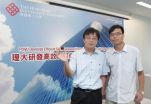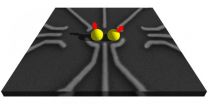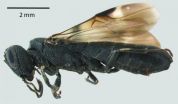(Press-News.org) Physicists from the Department of Nanophotonics and Metamaterials at ITMO University have experimentally demonstrated the feasibility of designing an optical analog of a transistor based on a single silicon nanoparticle. Because transistors are some of the most fundamental components of computing circuits, the results of the study have crucial importance for the development of optical computers, where transistors must be very small and ultrafast at the same time. The study was published in the scientific journal Nano Letters.
The performance of modern computers, which use electrons as signal carriers, is largely limited by the time needed to trigger the transistor - usually around 0.1 - 1 nanoseconds (1/1.000.000.000 of a second). Next-generation optical computers, however, rely on photons to carry the useful signal, which heavily increases the amount of information passing through the transistor per second. For this reason, the creation of an ultrafast and compact all-optical transistor is considered to be instrumental in the development of optical computing. Such a nanodevice would enable scientists to control the propagation of an optical signal beam by means of an external control beam within several picoseconds (1/1.000.000.000.000 of a second).
In the study, a group of Russian scientists from ITMO University, Lebedev Physical Institute and Academic University in Saint Petersburg put forward a completely new approach to design such optical transistors, having made a prototype using only one silicon nanoparticle.
The scientists found that they can dramatically change the properties of a silicon nanoparticle by irradiating it with intense and ultrashort laser pulse. The laser thus acts as a control beam, providing ultrafast photoexcitation of dense and rapidly recombining electron-hole plasma whose presence changes the dielectric permittivity of silicon for a few picoseconds. This abrupt change in the optical properties of the nanoparticle opens the possibility to control the direction, in which incident light is scattered. For instance, the direction of nanoparticle scattering can be changed from backward to forward on picoseconds timescale, depending on the intensity of the incident control laser pulse. This concept of ultrafast switching is very promising for designing of all-optical transistor.
"Generally, researchers in this field are focused on designing nanoscale all-optical transistors by means of controlling the absorption of nanoparticles, which, in essence, is entirely logical. In high absorption mode, the light signal is absorbed by the nanoparticle and cannot pass through, while out of this mode the light is allowed to propagate past the nanoparticle. However, this method did not yield any decisive results," explains Sergey Makarov, lead author of the study and senior researcher at the Department of Nanophotonics and Metamaterials. "Our idea is different in the sense that we control not the absorption properties of the nanoparticle, but rather its scattering diagram. Let's say, the nanoparticle normally scatters almost all incident light in the backward direction, but once we irradiate it by a control pulse, it becomes reconfigured and starts scattering light forward."
The choice of silicon as a material for the optical transistor was not accidental. Creating an optical transistor requires the use of inexpensive materials appropriate for mass production and capable of changing their optical properties in several picoseconds (in the regime of dense electron-hole plasma) without getting overheated at the same time.
"The time it takes us to deactivate our nanoparticle amounts to just several picoseconds, while to activate it we need no more than tens of femtoseconds (1/1.000.000.000.000.000). Now we already have experimental data that clearly indicates that a single silicon nanoparticle can indeed play the role of an all-optical transistor. Currently we are planning to conduct new experiments, where, along with a laser control beam, we will introduce a useful signal beam", concludes Pavel Belov, coauthor of the paper and head of the Department of Nanophotonics and Metamaterials.
INFORMATION:
Developing transparent or semitransparent solar cells with high efficiency and low cost to replace the existing opaque and expensive silicon-based solar panels has become increasingly important due to the increasing demands of the building integrated photovoltaics (BIPVs) systems. The Department of Applied Physics of The Hong Kong Polytechnic University (PolyU) has successfully developed efficient and low-cost semitransparent perovskite solar cells with graphene electrodes. The power conversion efficiencies (PCEs) of this novel invention are around 12% when they are illuminated ...
Calculation with electron spins in a quantum computer assumes that the spin states last for a sufficient period of time. Physicists at the University of Basel and the Swiss Nanoscience Institute have now demonstrated that electron exchange in quantum dots fundamentally limits the stability of this information. Control of this exchange process paves the way for further progress in the coherence of the fragile quantum states. The report from the Basel-based researchers appears in the scientific journal Physical Review Letters.
The basic idea of a quantum computer is to ...
DENVER, Colo. -- The International Association for the Study of Lung Cancer (IASLC) today issued a new statement on Tobacco Control and Smoking Cessation at the 16th World Conference on Lung Cancer (WCLC) in Denver. The statement calls for higher taxes on tobacco products, comprehensive advertising and promotion bans of all tobacco products and product regulation including pack warnings.
"Tax policies that increased the cost of cigarettes have played a prominent role in the reduction of cigarette smoking," said Dr. Kenneth Michael Cummings, Professor, Hollings Cancer ...
Scientists studying funnel-web spiders at Booderee National Park near Jervis Bay on the New South Wales south coast have found a large example of an unexpected funnel-web species.
The scientists believe the 50-millimetre spider is a species of the tree-dwelling genus Hadronyche, not the ground-dwelling genus Atrax, which includes the Sydney funnel-web, the only species reported in the Park's records.
"It's remarkable that we have found this other species in Booderee National Park," said Dr Thomas Wallenius, from The Australian National University (ANU).
"It shows ...
Graphene, the ultra-thin, ultra-strong material made from a single layer of carbon atoms, just got a little more extreme. University of British Columbia (UBC) physicists have been able to create the first ever superconducting graphene sample by coating it with lithium atoms.
Although superconductivity has already been observed in intercalated bulk graphite--three-dimensional crystals layered with alkali metal atoms, based on the graphite used in pencils--inducing superconductivity in single-layer graphene has until now eluded scientists.
"This first experimental realization ...
Social network Flickr and citizen science website BugGuide have helped scientists to expand the known range of a rarely collected parasitic woodwasp, native to the eastern United States. Partially thanks to the two online photograph platforms, now the species' distribution now stretches hundreds of miles west of previous records. Previously known from only 50 specimens mainly from the Northeast, now the species was discovered in the Ozark Mountains by researchers from the University of Arkansas. Their study is published it in the open access journal Biodiversity Data Journal.
Spurred ...
[Basel, Switzerland - 8 September 2015] The Drugs for Neglected Diseases initiative (DNDi) has announced today at the 9th European Congress on Tropical Medicine and International Health (ECTMIH) in Basel, Switzerland, the successful completion of Phase I human clinical trials for SCYX-7158 (AN5568), the first oral drug candidate specifically developed from the earliest drug discovery stage to combat human African trypanosomiasis, or sleeping sickness, a deadly parasitic disease transmitted by the tsetse fly.
The Phase I study, conducted in France, assessed the safety, ...
Edible dormice (Glis glis) spend about eight months on average in hibernation. Wildlife biologists from the Research Institute of Wildlife Ecology of the Vetmeduni Vienna have shown for the first time that these animals can hibernate for up to 11.4 months. "This may be a world record," says Claudia Bieber, co-author of the study. "Dormice in our climate zone don't just spend the winter months underground, they sometimes begin hibernating in summer."
The animals do not hibernate for so long every year, but only in years when beech trees produce few beechnuts. Successful ...
In the new study 'Building trust: Heart rate synchrony and arousal during joint action increased by public goods game' (Journal of Physiology and Behavior) PhD and assistant professor Panagiotis Mitkidis and colleagues from the Interacting Minds Centre at Aarhus University studied the link between heart rate and trust. They had 37 pairs of participants do a cooperative task involving building LEGO cars. The control group only did the LEGO task, while a second group played an investment game in between the building sessions. The game, known as the 'Public Goods Game', had ...
Select patients age 90 years and older with aortic stenosis (AS) can benefit from a relatively new, minimally invasive surgery for aortic valve replacement, according to an article in the September 2015 issue of the Annals of Thoracic Surgery.
Key points
Both transfemoral and transapical approaches to TAVR appear to be safe and effective for treatment of aortic stenosis in select patients age 90 years and older.
By 6 months post-surgery, most quality-of-life measures had stabilized at a level considerably better than baseline, meaning patients quality of life was ...




